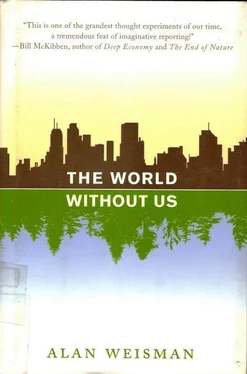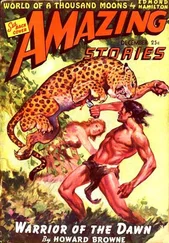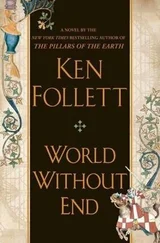
CHAPTER 12

The Fate of Ancient and Modern Wonders of the World
BETWEEN GLOBAL WARMING and ocean-conveyor cooling, if whichever dominates is partly muted by the other, as some models propose, Europe’s meticulous mechanized farmlands would, without humans, fill with brome and fescue grass, lupine, plumed thistle, flowering rapeseed, and wild mustard. Within a few decades oak shoots would sprout from the acidic former fields of wheat, rye, and barley. Boars, hedgehogs, lynx, bison, and beaver would spread, with wolves moving up from Romania and, if Europe is cooler, reindeer coming down from Norway.
The British Isles would be somewhat biologically marooned, as rising seas batter the already-receding chalk cliffs of Dover and widen the 21-mile gap that separates England from France. Dwarf elephants and hippopotamuses once may have swum almost double that distance to reach Cyprus, so presumably something might try. Caribou, buoyed by their insulating hollow hair, cross northern Canadian lakes, so their reindeer siblings might just make it to England.
Should some impetuous animal attempt the journey via Chunnel—the English Channel Tunnel, Le Tunnel sous la Manche —after human traffic ceases, it might actually make it. Even without maintenance, the Chunnel wouldn’t quickly flood like many of the world’s subways, because it was dug within a single geologic layer, a bed of chalk marl with minimal filtration.
Whether an animal would actually try is another matter. All three Chunnel tubes—one each for westbound and eastbound trains, and a parallel central corridor to service them—are swaddled in concrete. For 35 miles there would be no food or water—just pitch darkness. Still, it’s not impossible that some continental species might recolonize Britain that way: The capacity of organisms to ensconce themselves in the world’s most inhospitable places—from lichens on Antarctic glaciers to sea worms in 176°F sea vents—may symbolize the meaning of life itself. Surely, as small, curious creatures like voles or the inevitable Norway rats slither down the Chunnel, some brash young wolf will follow their scent.
The Chunnel is a true wonder of our times, and, at a cost of $21 billion, also the most expensive construction project ever conceived until China began damming several rivers at once. Protected by its buried bed of marl, it has one of the best chances of any human artifact to last millions of years, until continental drift finally pulls it apart or scrunches it like an accordion.
While still intact, however, it may not remain functional. Its two terminals are just a few miles from their respective coasts. There’s little chance that the Folkestone, England, entrance, nearly 200 feet above current sea level, could be breached: the chalk cliffs that separate it from the English Channel would have to erode significantly. Far more likely is that ascending waters could enter the Coquelles, France, terminal, only about 16 feet above sea level on the Calais plain. If so, the Chunnel would not completely flood: the marl stratum it follows makes a mid-channel dip and then rises, so water would seek the lowest levels, leaving part of the chambers clear.
Clear, but useless, even to daring migrating creatures. But when $21 billion was spent to create one of engineering’s greatest wonders, no one imagined that the oceans might rise up against us.
Nor did the proud builders of the ancient world, which had seven wonders, dream that in a span far shorter than eternity only one of them—Egypt’s Khufu pyramid—would remain. Like old-growth forest whose lofty treetops eventually collapse, Khufu has shrunk some 30 feet over the past 4,500 years. At first, that was no gradual loss—its marble shell was cannibalized during the Middle Ages by conquering Arabs to build Cairo. The exposed limestone is now dissolving like any other hill, and in a million more years should not look very pyramidal at all.
The other six were of even more mortal stuff: a huge wooden idol of Zeus plated in ivory and gold, which fell apart during an attempt to move it; a hanging garden, of which no trace remains among the ruins of its Babylonian palace 30 miles south of Baghdad; a colossal bronze statue on Rhodes that collapsed under its own weight in an earthquake and was later sold for scrap; and three marble structures—a Greek temple that crumbled in a fire, a Persian mausoleum razed by Crusaders, and a lighthouse marking Alexandria’s harbor, which was felled by earthquake as well.
What made them qualify as wonders was sometimes stirring beauty, as in the case of the Temple of Artemis in Greece, but more often it was simply massive scale. Human creation writ very large often overwhelms us into submission. Less ancient, but most imposing of all, is a construction project that spanned 2,000 years, three ruling dynasties, and 4,000 miles, resulting in a rampart so monumental that it achieved the status not just of landmark, but land form . The Great Wall of China is so staggering that it was widely, although erroneously, believed visible from outer space, serving notice even to would-be attackers from other worlds that this property was defended.
Yet, like any other ripple in the Earth’s crust, the Great Wall is not immortal, and far less so than most geologic versions. A pastiche of rammed earth, stones, fired brick, timbers, and even glutinous rice used as mortar paste, without human maintenance it is defenseless against tree roots and water—and the highly acidic rain produced by an industrializing Chinese society isn’t helping. Yet without that society, it will steadily melt away until just the stones remain.
Walling the Earth from the Yellow Sea all the way across Inner Mongolia is impressive, but for grand public works, few have matched a modern wonder whose construction began in 1903, the same year that New York inaugurated its subway. It was no less than the human race defying plate tectonics by tearing apart two continents that floated together 3 million years earlier. Nothing like the Panama Canal had ever been attempted before, and little has come close to it since.
Although the Suez Canal had already severed Africa from Asia three decades earlier, that was a comparatively simple, sea-level surgical stroke across an empty, disease-free sand desert with no hills. The French company that dug it went next to the 56-mile-wide isthmus between the Americas, smugly intending to do the same. Disastrously, they underestimated dense jungle steeped in malaria and yellow fever, rivers fed by prodigious rainfall, and a continental divide whose lowest pass was still 270 feet above the sea. Before they were one-third of the way through, they suffered not only a bankruptcy that rocked France, but also the deaths of 22,000 workers.
Nine years later, in 1898, a highly ambitious Assistant Secretary of the Navy named Theodore Roosevelt found a pretext, based on an explosion (probably due to a faulty boiler) that sank a U.S. ship in Havana Harbor, to oust Spain from the Caribbean. The Spanish-American War was intended to liberate both Cuba and Puerto Rico, but, to the great surprise of Puerto Ricans, the United States annexed their island. To Roosevelt, it was perfectly positioned as a coaling station for the still-nonexistent canal that would eliminate the need for ships sailing between the Atlantic and the Pacific to travel down the length of South America and up again.
Roosevelt chose Panama over Nicaragua, whose eponymous navigable lake, which would have saved considerable digging, lay among active volcanoes. At the time, the isthmus was part of Colombia, although Panamanians had tried three times to bolt from distant Bogota’s fitful rule. When Colombia objected to the U.S. offer of just $10 million for sovereignty over a 6-mile-wide zone bordering the proposed canal, President Roosevelt sent a gunboat to help Panamanian rebels finally succeed. A day later, he betrayed them by recognizing as Panama’s first ambassador to the United States a French engineer from France’s defunct canal-digging company, who, at considerable personal profit, immediately affirmed a treaty agreeing to U.S. terms.
Читать дальше












